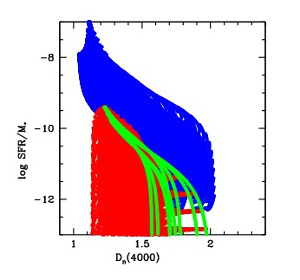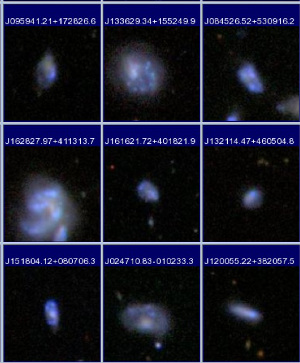 |
|
Figure 1:
The distribution of model galaxies, where the specific star formation rate is
plotted versus the strength of the 4000-Angstrom-break. Model galaxies that have
experienced continuous star formation histories are coloured in green, those
that are currently undergoing bursts are coloured in blue and those that have
experienced bursts in the past are coloured in red. One can clearly distinguish
the three groups, even if there is some overlap. Plots of the specific star
formation rate versus the Balmer absorption or emission line features show a
similar picture.
|
 |
 |
|
Figure 2:
Postage stamp images of some of the low mass galaxies in the SDSS that are
currently undergoing strong bursts.
|
|  |
Cosmological simulations of the evolution of cold dark matter (CDM) show that
the dark matter in galaxy halos forms cuspy distributions - with inner profiles
that are too steep compared with observations. This is commonly referred to as
the "cuspy halo problem". One solution to this problem, that was proposed early
on, is as a galaxy loses mass in the form of explosions this can lead to an
irreversible expansion of the orbits of stars and dark matter near the centre of
the halo. The very dense cusps would then be spread out over a wider area. These
conclusions, however, were based on simple analytic arguments and it was not
clear whether this mechanism could in fact produce central density profiles in
close agreement with observations. Later gas-dynamical simulations of dwarf
galaxies indeed demonstrated that repeated gas outflows during bursts of star
formation could in principle transfer enough energy to the dark matter component
to flatten 'cuspy' central dark matter profiles.
Nevertheless, it has remained unclear whether the energy requirements for
flattening cuspy profiles are in line with the actual stellar populations and
star formation histories of real low mass galaxies. In order to estimate how
frequently starbursts occur as well as the amplitude range in star formation
during a burst, it is necessary to analyze a large sample of galaxies that are
intrinsically similar.
High quality spectra provide a number of stellar features that are extremely
useful as diagnostics of the star formation history of a galaxy. A primary
feature is the strong break at 4000 Angstroms, caused by the blanket absorption
of high energy radiation from metals in stellar atmospheres. This break becomes
strong once young, hot, blue stars have evolved off the Main Sequence. In
addition, absorption lines from the Balmer series, which are strongest in stars
of spectral type A-F, are a diagnostic of the contribution of stars of
intermediate ages to the total luminosity of the galaxy. Finally, Balmer
emission lines arise in large, low-density clouds of gas where very recently
formed stars emit copious amounts of ultraviolet light that ionize the
surrounding gas (predominantly hydrogen).
Used in concert, Kauffmann (2014) found that these spectral features allow one
to clearly separate galaxies in three groups: those that are currently
undergoing a burst of star formation, those that have formed their stars
continuously and those that have experienced a burst in the past (Fig. 1).
Applied to a large sample of galaxies from the Sloan Digital Sky Survey, the
scientists were able to constrain the fraction of galaxies that were
experiencing current starbursts, the mass of stars typically formed in these
bursts, as well the duration of the starbursts. One could then investigate
whether the burst frequency depended on the mass of the galaxy and whether
starbursts were associated with changes in the internal structure of galaxies.
The analysis showed that the fraction of the total star formation rate in
galaxies with ongoing bursts was a strong function of stellar mass, declining
from 0.85 for the smallest galaxies in the sample to 0.25 for galaxies with
masses close to that of the Milky Way. Also the burst mass fraction, the
half-mass formation times and the burst amplitudes and durations could be
constrained. Finally, the scientists found that the central stellar densities in
bursting low mass galaxies are reduced compared to their quiescent
counterparts.
These results are in remarkably good agreement with predictions of some of the
recent hydrodynamical simulations and give further credence to the idea that the
cuspy halo problem can be solved by energy input from multiple starbursts over
the lifetime of the galaxy.
Guinevere Kauffmann
References:
Guinevere Kauffmann, Quantitative constraints on starburst cycles in galaxies
with stellar masses in the range 108-1010 Msun,  MNRAS (2014) 441 (3):
2717-2724 MNRAS (2014) 441 (3):
2717-2724
|



